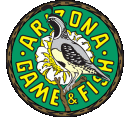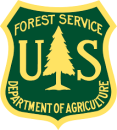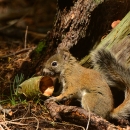Location
States
ArizonaEcosystem
ForestIntroduction
The Mount Graham Red Squirrel (MGRS), one of 25 subspecies of the American red squirrel, is endemic to mixed old growth conifer and spruce/fir forests above 2,425 meters (8,000 feet) in the Pinaleño Mountains in southern Arizona. This area is known as a “sky island,” rising to a maximum elevation of over 3,200 m (10,500 feet) on Mount Graham. Sky islands are high elevation mountain environments separated by “seas” of lowland desert scrub or grasslands that limit habitat connectivity. Mount Graham, located within the Coronado National Forest, is the highest of the sky islands, and supports the largest sky island mixed spruce and fir forest. Because MGRS range is limited to this isolated sky island, the species cannot colonize new habitat in response to disturbances.
The MGRS was thought to be extirpated in the 1950s, but a few individuals were rediscovered in the 1960s. The subspecies was listed as endangered in 1987, soon before the Mount Graham International Observatory was built in 1989. The construction of the access road and ongoing improvements have fragmented and further decreased habitat availability for the MGRS. Traffic has also caused MGRS casualties.
Since then, MGRS have been closely monitored and tracked by an interagency team. Surveys since 2001 have resulted in population estimates that fluctuated between 200 and 300 individuals until the 2017 Frye Fire, which was caused by lighting. The Frye Fire severely affected much of their habitat and reduced the population to 35 individuals. As of fall 2019, Arizona Game and Fish Department (AGFD) estimated that 78 individuals remained.
Key Issues Addressed
The quality of old growth habitat on Mt. Graham has been degraded due to a combination of prolonged drought, increasing frequency and severity of wildfires since the mid 1990s, multiple insect outbreaks, and resource competition with Abert's squirrels.
Long-term drought conditions cause physiological stress on trees, which makes stands of old growth conifers more vulnerable to other stressors, such as wildfire and insect infestations. Climate projections for increasing temperatures will make the Southwest more arid, likely contributing to further increases in intensity and frequency of fires and insect infestations.
Following the 1996 Clark Peak Fire, a suite of invasive insects, including bark beetles, a defoliating moth, and the spruce aphid, caused widespread tree mortality into the early 2000s. This die-off set the stage for the 2004 Nuttall Complex Fire to burn extensive standing dead biomass. The 2017 Frye Fire burned over 48,000 acres of the Pinaleño Mountains, including much of the Nuttall Complex Fire burn area and most of the habitat occupied by MGRS.
The resulting loss of Engelmann spruce (Picea engelmannii) and corkbark fir (Abies lasiocarpa) negatively affects MRGS by both reducing food availability and the abundance of cavities for nesting. Because of their low population size and isolation since the last ice age, MGRS may naturally lack the genetic variability needed to respond to these disturbances and recover their population.
Additionally, Abert’s squirrels were introduced to the Pinaleño Mountains in the 1940’s as a game species. This species is now more abundant than red squirrels. The two species have similar diets, so Abert’s squirrels further reduce the availability of food for MGRS.
Project Goals
- Protect and maintain a self-sustaining MGRS population
- Restore and create habitat to support species survival over time
- Conduct research on the conservation biology of MGRS to aid in its recovery
- Build partnerships to facilitate recovery efforts
- Monitor recovery progress and use results to continuously improve management
Project Highlights
Monitoring by Middens: In the fall, biologists count middens, or storage caches, created by MGRS on the forest floor to estimate the red squirrel population size.
- Supplemental Feeding Project: Immediately after the Frye Fire, biologists were concerned MGRS might not survive through the winter, as many of their middens were partially or completely burned. The interagency team implemented a supplemental feeding project to provide squirrels with a reliable food source through the first winter.
- Insect Pheromone Deployment: After the Frye Fire, Douglas-fir (Pseudotsuga menziesii) and southwestern white pine (Pinus strobiformis) trees that were scorched were at greater risk of being attacked by beetles, which could affect the limited food resources remaining for MGRS. The Coronado National Forest has since deployed pheromone packets in targeted areas to prevent these trees from being attacked in MGRS habitat. The Forest Service uses insect traps to detect when the harmful insects are present, and then staples packets directly onto trees.
- Cone Collection: Not only are MGRS unique to the Pinaleño Mountains, but the tree species are as well. Plant materials cannot be collected from other mountain ranges in the Sky Islands because this would introduce different genetics into the area, and the trees may not be adapted to this range. Between 2017 and 2019, Coronado National Forest collected cones from trees during bumper crops in the Pinaleño Mountains. Some of these trees are ready for outplanting during 2020.
- Silviculture and Fuels Treatments: The Pinaleño Ecosystem Restoration Project was designed to initiate forest restoration to provide long-term protection to the MGRS and its habitat by diminishing the risk of high-severity fire. It includes a variety of silvicultural treatments such as thinning large stands of dense trees, as well as fuels treatments like pile burning of tree limbs to prevent them from building up on the forest floor. These types of treatments aid in preventing high-intensity fires like the Frye Fire.
- Light Detection and Ranging Data:The US Fish and Wildlife Service funded a project to collect Light Detection and Ranging (LiDAR) data the summer after the Frye Fire. This data will be compared with a similar dataset collected in 2008, which should help biologists understand where pockets of habitat may remain on the mountain, as well as areas for potential revegetation and restoration activities.
- Abert Squirrel Removal: Beginning in 2018, AGFD funded a project to remove Abert’s squirrels from areas that overlap with MGRS and decrease resource competition with MGRS. To date, removal is completed by shooting squirrels. Through coordination with the University of Arizona red squirrel lab, most carcasses are used for research. For example, researchers are analyzing parasite loads that may or may not have affected MGRS.
- Captive Breeding Programs: The Arizona Center for Nature Conservation at the Phoenix Zoo initiated a captive breeding pilot program in 2014 to determine the husbandry needs of the squirrel and potentially help increase MGRS populations in the wild.
Lessons Learned
Saving this unique subspecies cannot be done alone. Many agencies, organizations, and individuals are working hard to make sure MGRS does not disappear before our eyes. The U.S. Fish and Wildlife Service, Coronado National Forest, Arizona Game and Fish Department, Phoenix Zoo, and the University of Arizona are all working together on resourceful ways to help recover MGRS. It will take creative, collaborative thinking and consideration of all the research and management tools in the toolbox to ensure MGRS persists on the landscape and remains a part of Arizona’s incredible diversity of wildlife.
Supplemental feeding following the Frye Fire appeared to be successful. Biologists were able to photograph squirrels using supplied food, and overwinter survival was high. Once food became more available, MGRS decreased their use of supplemental feed. Supplemental feeding is an intensive effort that requires replacement of feed every two weeks and is likely only appropriate for temporary, emergency applications.
Partners have been able to collect and store native tree seeds collected from cones. Successful collection requires identifying trees that will produce a bumper crop in a given year, and then being prepared in advance to be on the mountain for the two week period in the fall when they are ready to be harvested.
Effective communication and coordination between biologists, land management agencies, and contractors, preferably in-person, increases the efficiency of treatment and recovery efforts. For example, biologists should be in the field when important silvicultural decisions are made to avoid mistakes that lead to project delays.
The impact of Abert’s squirrel removal is difficult to determine, especially without having a “control” site. However, it is understood that Abert’s squirrels will never be eradicated from Mount Graham, and long-term funding is needed to have a lasting impact.
The Phoenix Zoo has been able to keep MGRS alive and healthy in captivity. While squirrels have not yet successfully reproduced in captivity, biologists have gained many valuable insights about the species, such as discovering through hormone analysis that females have multiple windows of receptivity during the breeding season.
The deployment of insect pheromones appears to be resulting in reduced damage to Douglas fir and southwestern white pine. However, as for some of the other recovery actions, the direct effects are difficult to quantify due to the lack of a control site.
Next Steps
- In the short-term, fuel reduction treatments will be completed through burning of piled material remaining from thinning treatments. Biologists are working with researchers to assess the effectiveness of silvicultural treatments in reducing the frequency and intensity of wildfire to inform future management.
- The Coronado National Forest is also developing a FireScape project for the Pinaleño Mountains to more comprehensively address forest health issues mountain-wide and reduce the risk of high-intensity fires.
- The US Fish and Wildlife Service is initiating a Species Status Assessment to address MGRS’s reduced abundance and inform the recovery process.
- All partners will continue to work together on projects to benefit MGRS both short- and long-term. This includes considering reforestation efforts in areas severely affected by the Fyre Fire and incorporating LiDAR data to determine habitat changes, remaining habitat available, and potential areas for restoration. Partners now have douglas fir seedlings ready to be planted in previously burned areas.
- Efforts will continue to prevent further insect outbreaks, remove Abert’s squirrels in targeted areas on the mountain, and breed MGRS in captivity for potential future release to enhance the wild population.
Funding Partners
- U.S. Fish and Wildlife Service
- U.S. Forest Service Coronado National Forest
- Arizona Game and Fish Department
- Arizona Center for Nature Conservation/Phoenix Zoo
- University of Arizona
Resources
- US Fish and Wildlife Service Information Page on the Mount Graham Red Squirrel Page
- Draft Mount Graham Red Squirrel Recovery Plan, First Revision (2011)
- University of Arizona Article on Insect Outbreaks on Mt. Graham
- Derbridgec, J., J., and Koprowski, J., L. (2019). “Experimental removals reveal dietary niche partitioning facilitates coexistence between native and introduced species.” Ecology and Evolution 9(7): 4065–4077.
- Frye Fire Burned Area Emergency Response (BAER) Informational Website
- Mt. Graham International Observatory Website
- 1986 Draft Environmental Impact Statement for the Mt. Graham Observatory
Contacts
- Marit Alanen, Fish & Wildlife Biologist, US Fish and Wildlife Service: marit_alanen@fws.gov
- Brittany Garza, Fish & Wildlife Biologist, US Fish and Wildlife Service: brittany_garza@fws.gov
Case Study Authors
- Marit Alanen, Fish & Wildlife Biologist, US Fish and Wildlife Service: marit_alanen@fws.gov
- Sierra Riker, CART Intern, Northern Arizona University
- Caitlyn Aymami, CART Undergraduate Research Assistant, University of Arizona
Suggested Citation
Alanen, M., Riker, S., and Aymami, C. (2020). “Recovery Efforts for the Mount Graham Red Squirrel.” CART. Retrieved from https://www.fws.gov/project/mount-graham-red-squirrel.









